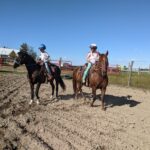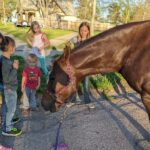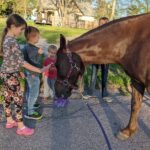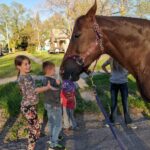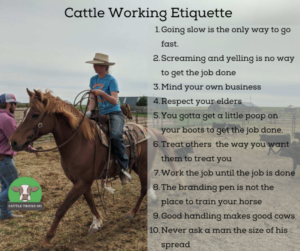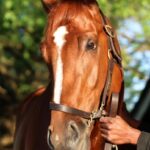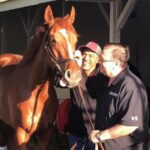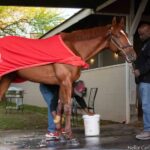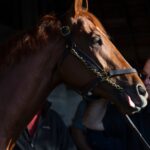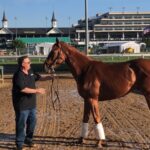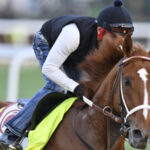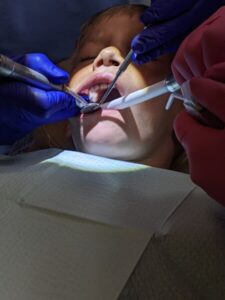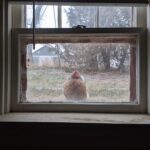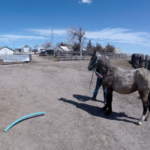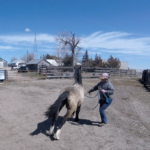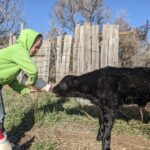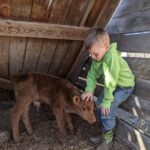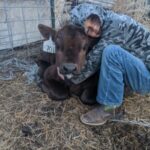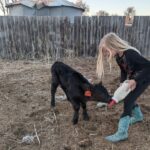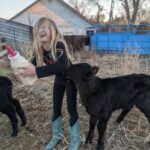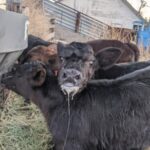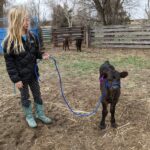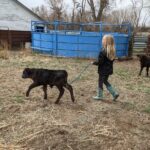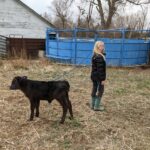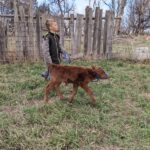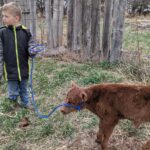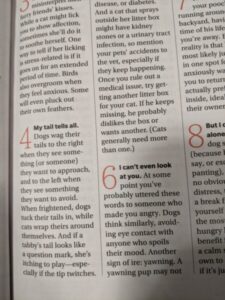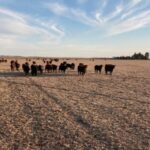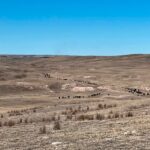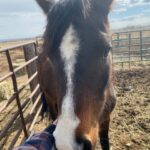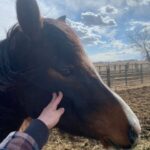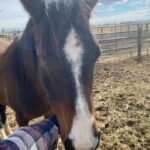Life Lessons Learned While Working Cattle
- Going slow is the best way to go fast.
When we rush to get a job done it always takes twice as long. When we run the cattle or hurry the horses they sull up and work slower or blow up and it all goes to heck. If we pause a moment and let everything settle and look around they have time to make the decision to go forward calmly and comfortably.
2. Screaming and yelling is no way to get the job done
I once had a neighbor help work calves. The usually quiet agreeable herd didn’t know what to do with all his yelling and suddenly refused to go through gates or would all take off. Once I convinced him to stop screaming and waving his arms, to instead walk through them quietly and ask politely, they went back to their usual selves and everything worked much easier. People and animals respond much better to being asked nicely than they do to screaming.
3. Mind your own business
Yes, it’s best not to pry into what your neighbor is up to, but in this case, your business is the cows in front of you. Don’t cut in front of someone else to get the cattle moving there. Every rider, when moving cattle, has a pie shaped wedge out in front of them. Figuratively of course 😉 The rider at the narrow end, with it widening at the herd. That is their business. The wedges over lap at the corners. But you never, ever, unless it is an absolute emergency and the whole herd is about to disappear down a deep draw, leave your place to get into another riders space. To do so is insulting to everyone helping and makes you look bad.
4. Respect your elders
It takes time and experience to earn the top jobs at workings. The right to rope, brand, or castrate are earned. The young people get to wrestle calves, and do what ever else they are asked to do. Just jumping on a horse and deciding you are going to rope is not ok.
When working in a chute, running the chute and giving shots are the top of the hierarchy. Everyone else pushes cattle into the chute or brings them in from the corrals. All the jobs are important. One can’t be done without the other. There is nothing wrong with stepping back and acknowledging the age and experience of those you are working with. Being asked to do more is a far better than to be asked to step back.
5.Sometimes you gotta get a little poop on your boots to get the job done.
Nothing worth doing was ever done without putting in the hard work to get it done. That means wading into the deep mud, getting into the poop, rolling up your sleeves and getting done what needs done.
6. Do unto others what you would have them do unto you
Sometimes cows get into a different pasture. Fences get down. Things happen. We can make the decision to make it right or quietly let it go. It can be a little too easy to let things slip when they are to our benefit. Do we pick up the phone a little faster when the neighbors cows are out on our pasture? Do we wait a little longer to get cattle in when they’re on the neighbors pasture? Doing the right thing even when it isn’t to our benefit can be hard, but it’s still the right thing to do.
7. Do the job until the job is done
It doesn’t matter if it’s hot and you think you might die of thirst before you can refill your canteen, or so cold you can’t feel your extremities, or so late you are about to fall asleep in the saddle. When there’s a job that has to be done, it has to be done. The cattle’s health and comfort comes before the person’s. That’s how this life works. Now on the other hand, sometimes that job doesn’t HAVE to be done now. There’s no reason not to let is wait until after presents have been opened on Christmas, or after the big parade in town. The trick is knowing the difference.
8. Branding, cow working is not the place to train your horse
Yes, young horses need to get out and experience life in order to learn how to be a good horse. But there’s a fine line between getting that experience in and messing up the workings. When there’s a job to be done and people around that could get hurt is not the time to build that experience. Cattle working, especially when they’re not your own, is not the place to get a colt with 30 days on used to crowds and noise.
9. Good handling makes good cows
We’ve all seen those herds that scatter when they spot a horse, or 4wheeler. We tried to work the cattle that ball up or refuse to go through a gate to sort. Some cattle are just hard to work.
But maybe it isn’t the cows. Cattle are trained to handle, just like horses. The time we spend with them, the way we work them, all influences how they handle. We can change our working style, stop yelling, see lesson #2, slow down, lesson #1, and take a close look at the working facilities. Is the set up arranged in a way that allows for easy movement? Is it mostly free of shadows, dark or light places that will make it hard for the cattle to see where they will be going?
While we’re working on ‘training’ our cattle to handle well we can do some actual training. Run cattle through the chute one time without working them. Let them see what and where. The next time they will have learned that going through the chute lets them ‘escape’ and they’ll run right through. Knowing the routine is important for cattle, they are creatures of habit. Make sure they know what is coming and they will work with you instead of against.
10. Never ask a man the size of his spread
Seriously. It’s just rude.
Rich Strike, HorseWhorls
As much as I hate to do this, I’m jumping on the bandwagon. Normally I have no interest in racing, but a cool horse is fun to look at no matter his sport.
This isn’t about racing, for good or bad. Comments arguing about that will be deleted if they get mean. This is about the whorls!
It’s hard to find good pictures of a horse no one had any interest in a few days ago. I searched the internets and these are what I was able to shamelessly ‘borrow’.
It looks to me like he has a slightly high whorl. That doesn’t come as any surprise because more than half of all thoroughbreds have high whorls. A slightly high whorl shows slight extrovert traits.
Extroverts are very invested in the external world, everything going on around them. They want to go, to be moving all the time. Intelligent, emotional, and sensitive they will be as brave as they can be and eager to please with a sensitive supportive rider or a nervous wreck with a harsh rider who doesn’t give the support they need.
His ears show sensitivity and energy. But they are widely set enough to add in sensibility and saneness. His nostrils appear to be large and wide open, even in the still pictures. That shows an ability to get plenty of air for endurance and easier learning.
From the side we see a somewhat convex profile. That shows physical toughness and determination. It isn’t a straight profile, so there should be some quirks. Something to keep life interesting. His chin is hard to see but doesn’t appear to be complicated for a matching temperament.
We can’t see much of the body whorls in any of these pictures. Except a crest whorl I think, up just behind the ears and feathered. The whorls on the crest of the neck show where they will bend through the neck when they tuck their nose. When the whorls are feathered they will bend through the length of the feathering instead of the single point of the whorl.
Nothing extreme about any of the whorls, just a nice energetic horse with enough extra to give him plenty of character. Sensitive and energetic, but sane and tough.
- May 5, 2022; Louisville, KY, USA; An exercise rider works Kentucky Derby alternate Rich Strike during morning workouts at Churchill Downs. Mandatory Credit: Jamie Rhodes-USA TODAY Sports
The Dentist
It started out the way so many situations do with our horses. Something is supposed to be easy. After we have already started, to far in to stop, the horse says no. It isn’t easy at all and they want nothing more to do with it. But we have to finish. It isn’t safe to stop where we are, or in the case of vet or farrier visits things can’t be left undone.
We need to get the job done. Whatever it takes.
Only instead of a horse this was my son.
He doesn’t like the dentist, but he had held up long enough for the cavity to be drilled out. There was an open hole in his tooth and he wasn’t going to let them do anything about it. No way no how.
So, we got the job done. It was not a good or pretty thing. It left me traumatized so he must have been in an awful state. Unfortunately the patch was the quickest easiest possible. It wouldn’t last. They would have to try again.
So we started training. We reenacted the scenario as best we could. Laying back and letting me look in his mouth. Adding bright lights shining down at him and poking around. We even got to do a practice run getting a cleaning without any teeth work done. Like with a horse traumatized by a bad vet visit it wasn’t smooth sailing. Everything took time and patience. Large rewards were needed.
Today it was time for the real deal. Our second chance to see if all the prep work had worked.
We got there right at the appointment time. I thought less time to think about it would help. They were running late. He was huddled in my lap. I thought it was never going to work. Instead all that extra time gave him time to settle and relax.
By the time they called us into the office he was calm and happy. He watched his sisters teeth get worked on, then he was huddled in my lap again. I offered support, comfort, and distraction. Yelling and forcing would get us no where. Isn’t it amazing how the principles are the same no matter the species?
Once they finished up with his sister he got to sit in the chair and wait. I thought it was going to lead to trouble. Instead, once again, time to sit, get accustom to the new place and idea, let him calm down. By the time the dentist came back he was ready to go. They let him see the tools, demonstrated how they worked as much as possible, and, most importantly, gave him a stop cue. Anytime he needed them to stop all he had to do was raise his hand.
Allowing a horse or human control over their training, work, medical care, is a reinforcer all by itself. Control, a say in your destiny, can change everything. If we allow our horses to say no when they aren’t happy with what is going on they are far more likely to say yes. That is exactly what happened here. Any time he held up his hand they stopped and sat back, allowing him to sit up and take a break. When he did that I came in and offered what support and comfort I could. Rewarding him for stopping, offering comfort and support, instead of encouraging him to make them stop more often, helped him to keep going. We aren’t training a horse to be ‘bad’ by comforting them. Being nice isn’t letting them win. It is giving them what they need to face fear. If we are a safe place they will turn to us when afraid and trust us to get them through it. If we insist on being the boss and making sure they don’t ‘win’ they will fear us as much as whatever else is out there to get them and tell us no at every opportunity.
With all the reinforceres we all could offer, with comfort as a high priority, and being allowed to say no when he needed, he made it through the dentist for the first time ever. We overcame the past bad experiences and instead of huge withdrawals from the trust account ended with a larger deposit than we started with! Learning theory and what we do with our horses applies to anything that we can possibly train. That makes this relevant to horse training. It is a story of training success.
Of course we went for ice cream after. Excellent behavior deserves a jackpot reward!
Heavenly High Whorls
They’ve just got to be extra. They can’t help themselves. It’s who they are.
Not that it’s a bad thing.
They have big personalities, big emotions, big sensibilities.
When a horse has one single whorl placed above eye level they will be an extrovert. Extroverts are very aware of all the things going on around them. They don’t miss a single thing. That can be great if you want a cutting horse who will get down and work a cow, never missing a move they make. If you were hoping to walk quietly down the trail on a horse who wont take a wrong step it might make life a bit more exciting than you had hoped for.
With all their emotions out there for everyone to see their feelings are easily hurt. Force and a heavy hand will leave them crumpled and crying on the ground.
If you recognize their need for attention and adoration they will sparkle and shine, doing their best to please and putting on a brave act to show you how much they can do.
Right brain or left brain extrovert does make a difference. Right brain will be your artist, emotional and sensitive, even more so. Left brain, a brainiac, curious and lacking in some basic social skills as they stick their nose in your business wanting to be involved, to help, if you’d just move over and let them they really could do it for you.
Either one is crazy smart, able to figure out what you want faster than you can. It takes a lot to stay ahead of them, keep them entertain and busy. All without crushing their delicate flower like feelings. When you can manage that they will love you desperately. Gazing at you with those huge puppy dog like eyes in adoration. A high whorl can never get enough love and gentle affection. To pet them too hard is akin to an attack, especially when the right brain is at the helm. To get it just right with them is to gain a devoted follower for life.
Spring Cold
Spring Cold is somehow worse than winter cold.
We’ve had a taste of warm. A reminder of summer to come. We’ve been lured into forsaking our long underwear, scarves, and accoutrements. Remembering and realizing that we will need them again is hard, until it’s time to break ice again and thighs have frozen solid. Then you remember the things you forgot. To late to go back for them, to early to remember the next day.
After a day or two without the wind is back. I pitch hay to the horses, against the wind. It all blows into my face and I feed them on the ground instead of the feeder trying to keep some of it where they can catch it as it blows. Everyday as the wind howls I sing the song of The Wreck of the Edmund Fitzgerald to them. Apologizing because “it’s too rough to feed ya”.
The exact lyrics if there’s actually anyone out there who doesn’t know the song:
“When afternoon came it was freezin’ rain
In the face of a hurricane west wind
“Fellas, it’s too rough to feed ya””
Tail Tells, HorseWhorls
I love Readers Digest, there is always some gem to be found in there.
In this months it was an article talking about pets and what they are trying to tell us. Included was that when a dog wags their tails to the right they are curious, interested, engaged, they are working from the left side of the brain. When dogs wag their tails to the left it shows they are worried or fearful, working from the right side of their brain.
It is along the same lines as a horse spooking and running to where they can put their left eye on the thing that scared them. The right side of the brain manages reactions, fear, emotions. Because the left side of the brain is more strongly connected to the right side of the body and vice versa the left eye is connected to the right side of the brain.
But, the same article informed us all that all dogs really prefer to be inside. With one such blatantly false statement it left the rest of the article in doubt, so I went looking for other sources.
(Yes, many dogs undoubtedly do prefer to be inside. Not all, not by any stretch. Dogs who are suited to the weather and outdoor play with plenty of enrichment in their environment, much prefer playing outside to being stuck inside all day.)
I was able to find lots of support for this statement! which was great because it goes right along with everything I believe to be true.
Dog tails are not whorls, but they are outside clues to the inside workings of the body, Tails can offer a wealth of information, aside from which direction they are waging to. They can tell us if the dog is happy, scared or aggressive. A wagging tail does NOT automatically mean a happy dog. I’ve seen people who misinterpret that and get themselves in trouble with dogs who were clearly asking to be left alone.
Do you know what your dogs tail is trying to tell you? This is a great article that covers the basics. https://vcahospitals.com/know-your-pet/interpreting-tail-wags-in-dogs
What about horse tails? Because they don’t ‘wag’ the signals they give are a bit different than dogs. They can clamp down to show fear. They can flag up in the air to show joy and exuberance. They can be carried to the side to show physical issues, pain onside or outside the body. Does anyone else have a clue we can read in a horse’s tail?
Sensible Single Whorls
Those single whorl horses. They have an amazing reputation in the horse whorld. Steady, dependable, unchanging. They are the unicorn of whorls.
Yes, this is mostly deserved. It’s entirely possible that they can be those things.That single whorl shows a lack of extremes. Extremes are good to avoid with anything in life. The middle of the road, a little of everything and not too much of anything.
Most of the time a single whorl comes with a straight profile, squared off muzzle, a very rectangular shaped head. All the things that come with a steady dependable horse.
Most of the time.
Those times when they don’t are the time people say whorls don’t work. They say they had a single whorl horse and he didn’t fit any of the expectations!
That is why we can’t just look at the whorl when we have a single whorl. It tells us there are no extremes to be seen in the whorl, not that there are no extremes at all. Sometimes the head shape will show us differences in temperament, sometimes it will be other whorls on the head. A center whorl is a good solid steady starting spot but it isn’t the entire journey. Here more than any other whorl the details are the important thing. Is the profile dished? Rounded? Are there quirk bumps? Or is the profile straight to keep that center whorl sensible.
When all the features are aligned a single center whorl is the perfect whorl to look for for people who want a quiet, dependable horse who is the same horse every day, without the drama and excitement of more complicated whorl patterns. Baby sitters and trusted rides single whorls are usually the trusted stand by that people reach for again and again.
Cowboy Camp
When we are looking at horses, to buy, to choose for a particular discipline, looking at the whorls first can save a lot of heartbreak in the long run.
There are no bad whorls!
But, there might be whorls that aren’t as well suited to certain pursuits. On the other hand there are some whorls that end up being good for the role the horse ends up playing in life purely by accident.
This lovely mare is a rescue. She is almost completely blind. The believe she can see a sliver out of the right eye and that is it. This nearly blind mare is going into training. How far the training goes will depend on how she does and how she feels about things but she’s almost ready for a first ride.
There are some horses who wouldn’t be able to begin a riding career without good eye sight. This mare’s head shape should work in her favor to help everyone down this chosen path.
Her forehead whorl is slightly high and slightly to our right. That shows a horse who will display slight right brain extrovert traits. Emotional, sensitive, reactive. How strongly those traits will show depends on the shape of the head and all her other features. A right brain extrovert can be scared of everything and reactive to the point of difficulty. Especially when handled roughly. On the other hand, they can be sweet and loving and put all those nerves towards wanting to please. It’s all in the extremes and how they are handled. The ’emotional’ can mean they love to the extreme. They want to be with you, they want to be loved.
Her whorl is paired with ears set wide at the base and wider at the tips. Those add stability, willingness, and intelligence.
From the side is where we start to see so much more to her character. She has a strongly dished profile, more sensitivity and emotion to go with the whorl, but below that she has a very impressive moose nose. The moose nose counters the sensitivity and adds boldness and confidence. Not that she wont be sensitive but it will be grounded. She will feel your every emotion and be brave enough to act on your every request. If you offer her right brain side support and comfort.
I hope to hear more about this lovely mare as her training progresses. She ended up having a perfect whorl for the job, purely by accident.
